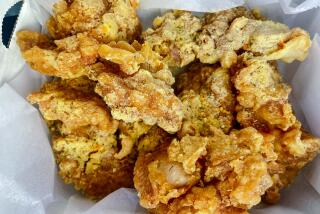Potato Redux : As the Dining Public’s Interest in French Fries Ebbs, Industry Seeks New Ways to Prepare the Lowly Spud
- Share via
We drown them in ketchup, frost them with salt and even dab them in mayonnaise. We debate the virtues of the skin-on versus skin-off varieties or thick-and-meaty versus thin-and-crispy. We give them funny names, such as Curly-Qs and crinkle cuts.
Whatever they are called, the french fry and its many cousins--the tater tot, hash brown and assorted fried potato products--have been longtime American favorites.
But in recent years, the love affair between consumers and the french fry has cooled off a bit. Industrywide sales of fried spuds--estimated at about $5 billion annually--have remained flat following years of rapid growth during the 1970s and early 1980s.
Increasingly crowded menus and the rise of ethnic foods have eaten away at the french fry’s popularity. Many health-conscious Americans have also curbed their appetites for fried foods and have turned instead to such items as baked potatoes, pasta and salads.
And as baby boomers age, their enthusiasm for fast-food restaurants--where most fries are consumed--tends to fade in favor of eating at sit-down restaurants or dining at home, say analysts. An aging population also means a smaller pool of young people, who are the biggest group of french fry eaters.
So, many french fry makers are tinkering with their product to win consumers back. The spuds have been twisted and cut into new shapes, flavored with seasonings and stuffed into ever-bigger packs intended to keep customers coming back for more.
Besides gurgling in the deep-fat fryer, fries are popping out of microwave ovens and toasters and are being dispensed from vending machines. There has even been a move to put the fatty french fry on a diet to make it more appealing to health-conscious adults.
“I think because of menu proliferation, potato packers are going to have to become much more creative in the types of products we put in front of consumers,” said Ronald L. Cowan, vice president of the processed potatoes division at Carnation Co., a major supplier of frozen fries to the restaurant industry.
Still, analysts do not expect the french fry to disappear from the American diet or restaurant menus anytime soon. Consumers gobble up about 5 billion pounds of fries annually. About 79% of American restaurants served french fries, according to a 1986 survey by the Restaurant Business magazine.
“Having french fries with a hamburger and a soda is still the American way,” said Cowan.
America’s affection for fried potatoes has a long history. Thomas Jefferson is said to have served up fries in the White House. And during World War I, American Doughboys with a bad sense of geography coined the term “french fries” for the tasty shoestring fries sold in Belgium, said Meredith Hughes, treasurer of the Potato Museum in Washington and editor of the organization’s newsletter--Peelings.
Like many Americans, Hughes has a favorite style of fry: “I favor them as thin as possible, homemade and preferably dipped in mayonnaise--you ain’t lived.”
For fry fanatics, fries-only chains--like Boardwalk Fries--have sprung up that sell buckets of fried potatoes smothered in gravy or barbecue sauce. “People like to have chili and cheese combined with their potatoes and sometimes with jalapeno (peppers),” said Stanley Berkson, who operates six Boardwalk franchises in California. “It’s a meal--you eat one of those and you’re full.”
The humble french fry can even be found in some of the classiest restaurants. At Michael’s in Santa Monica, customers plunk down $10 for a large side order of pommes frites-- fried in lard. “They are pretty popular,” chef Martin Garcia said.
This mania for fries has bred a multibillion-dollar industry that has enriched potato growers, french fry makers and restaurants.
About half of the nation’s $2-billion-a-year potato crop is sliced, diced and reconstituted into fries in automated plants that feature computers and lasers. Thanks to being a major supplier of frozen fries to McDonald’s, potato processor John R. Simplot has built a fortune valued at $400 million, a company with annual sales of more than $1 billion and a spot on the Forbes magazine list of the 400 richest Americans.
And although fast-food chains may brag about their burgers, much of their fortunes rely on their fries, which may account for up to 25% of sales at some outlets. About half of the nation’s fries are consumed at the top 10 fast-food chains, according to industry analysts.
Plenty of Profit
“If you’re a hamburger chain, you have got to have a real good french fry,” said David Bekermeier, vice president at Technomic, a Chicago-based restaurant consulting firm.
A typical restaurant can make 80 cents to 85 cents of profit on $1 worth of french fries sold, say analysts. That compares to about 70 cents of profit on a $1 hamburger. “They are probably one of the most profitable items that you have in a fast-food operation,” said Bill Main, a Northern California restaurant consultant. “It’s one of the easiest items to prepare. All they do is open the packet and throw them in the fryer.”
At McDonald’s, which sold 755 million pounds of its famous shoestrings last year, three out of five customers buy a pack of fries with their order. “We at McDonald’s consider the french fry our flagship product,” said Jerry Randklev, quality assurance manager for potato products.
Growing Boredom
With so much riding on fries, it is no wonder that french fry makers are looking at new ways to boost sagging sales and reverse what some perceive as Americans’s boredom with the standard fry.
“That’s why you get skin on fries,” said William Norton, a fast-food consultant in Minneapolis. “It looks much more upscale, and then the consumer thinks they are better. People are starting to do a lot more things with fries.”
But some of these fancy new fries may not help much. “I don’t see (sales) going up, I see them flat at best,” said Bekermeier at Technomic. “Menus used to list a cheeseburger, hamburger, french fries and Coke--that was it. Now you can get a taco, you can get a burrito, you can get a salad.”
Some new products, however, have met with success. The 2,000-unit Arby’s chain recently introduced the Curly-Q Fry, which is cut in a spiral shape and seasoned.
“It’s actually selling every bit as good as the regular french fry, “ said Ira Hermann, Arby’s executive vice president and chief operating officer, who expects overall fry sales to increase 15% because of the Curly-Q. Besides being more profitable than its regular fries, the Curly-Q, he said, “makes us distinctive.”
One way french fry makers hope to boost sales is by introducing products that will be sold outside of restaurants.
At Ore-Ida, for instance, the company is testing french fry vending machines in Chicago. The computer-controlled machines are designed to deliver a fresh batch of fries in 35 seconds. If the test proves a demand for the product, Ore-Ida said it plans to install about 1,600 machines next year and as many as 60,000 in the next five years.
Microwaveable Fries Next
Companies are looking at microwaveable fries as a means of boosting lagging supermarket sales of fries and taking advantage of a boom in microwave ovens. But executives say many microwave fries lack the crispy exterior fry lovers crave.
“Right now the consumer has voted on what’s out there and with kind of mixed reviews at best,” said David Kelley, director of marketing at Lamb Weston, a potato processor.
French fry makers and restaurant owners are also looking at ways to improve the appeal of the fry to health-conscious Americans. About 20 pieces of fries cooked in beef fat account for 274 calories and 13.2 grams of fat--almost 25% of the daily fat intake recommended by health experts. “We recommend that people stick with a baked or a boiled potato,” said Bettye Nowlin, a registered dietitian and spokeswoman for the American Dietetic Assn.
Many restaurants and potato processors now use cholesterol-free vegetable shortening instead of beef fat to fry their french fries. Yet this method still leaves the fry heavy with fat.
“We need to make a stronger attempt at reducing the fat content of french fries, said Cowan at Carnation. “All the major packers are working on it now.”
But many in the industry argue that when it comes to fries, more consumers are concerned about taste than health.
“What it comes down to is taste,” said product marketing executive Paul Haack at Jack in the Box, which recently introduced a larger pack of fries that has since outsold the smaller pack. “People talk about nutrition but then the taste buds take over. And those french fries are so good.”
More to Read
Eat your way across L.A.
Get our weekly Tasting Notes newsletter for reviews, news and more.
You may occasionally receive promotional content from the Los Angeles Times.










